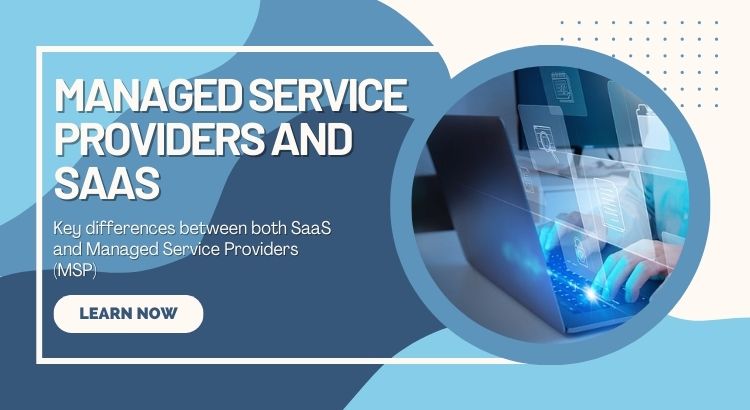According to Gartner, the global SaaS market is expected to reach $623 billion by 2023, growing at a CAGR of 18% from 2019 to 2023. This is just a model. Another, which is the SaaS model, is also rising in demand.
While both offer cloud-based solutions, they cater to different business requirements and offer distinct benefits and challenges. This article explores the key differences between SaaS and MSPs, highlighting their roles, benefits, and considerations, supported by complementary statistics.
The technology world is evolving rapidly. And organisations are increasingly inclined towards various advanced technology models. Two popular models are predominantly rising in demand. These are software as a service (SaaS) and managed service providers (MSPs). Interestingly, both of these services offer cloud-based solutions, and each comes with its own upsides and downsides.
In this post, you can discover key differences between both SaaS and Managed Service Providers (MSP). So, let’s dive into these models and understand why they are different.
1. Definition and Scope: SaaS (Software as a Service)
SaaS expands for Software as a Service. It is a service provided by a third-party provider that hosts applications and lends them to its customers over the Internet. Unlike in-house software on local machines, users can access them through a web browser. Typically, these applications are offered on the basis of subscription. Considering the cost, it varies according to the number of users, features preferred, and level of support required.
B2B SaaS Marketing has emerged as a crucial aspect of the SaaS industry, with companies investing heavily in targeted marketing strategies to reach enterprise customers.
Unlike traditional software marketing, B2B SaaS marketing focuses on demonstrating long-term value, ROI, and scalability to business decision-makers.
This includes content marketing, account-based marketing (ABM), and customer success stories highlighting the transformative impact of SaaS solutions on business operations.
Definition and Scope: Managed Service Providers (MSPs)
Unlike software, managed service providers (MSPs) refer to IT experts with a specialty in IT managed services. Basically, they provide IT management services, which range from monitoring, maintenance, and support for different IT infrastructures and applications. Instead of delivering specific software applications, MSPs engage in the holistic management of the technology needs of an organization. Specifically, these services include network and software installation, management, cybersecurity, data backups, and disaster recovery services. Overall, these professionals provide expertise and resources that an organisation might not have in-house.
2. Service Model and Delivery—SaaS
SaaS applications are hosted on servers, and users can access them through an internet connection. It offers flexibility to use anytime and scale up or down according to requirements. As aforesaid, this service runs on a subscription model. The subscription cost is defined according to features and users. Moreover, users have to configure it to use the software. In case of needing support, its provider provides assistance in installation and maintenance. And then the user has to manage his data and application settings.
Service Model and Delivery Managed Services Delivery
Unlike limited SaaS support, MSPs offer end-to-end IT resource management. Most of it includes servers, networks, and applications, which are proactively monitored, repaired, and maintained. Since it’s a service, MSPs typically agree to serve in writing. A service level agreement (SLA) is drawn up, outlining the level of services, response times, uptime guarantees, costs, maintenance, and assistance.
These professionals dedicate their services to handling IT operations so that the beneficiary company can continue focussing on strengthening its core activities. All in all, their support and expertise resolve issues that are beyond any software and applications.
3. Cost Structure: SaaS Costs
A subscription model of SaaS consists of predictable features and costs. It can help with cost-benefit according to the financial planning and expectations of a business. Typically, businesses can leverage a lower upfront cost without the need to purchase a software license and hardware.
Cost Structure: MSP Costs
MSPs’ costs can be defined through services sought after, the number of devices, and the level of support required. The provider may decide on the monthly fee, which may be fixed according to devices and customer support. Overall, these services are offered under the pay-as-you-go model.
However, this alternative may also involve negotiation over the cost. The provider can reduce the need for in-house IT staff, which certainly adds to the holistic budget of a company.
4. Customisation and Integration—SaaS Customisation
SaaS applications are prebuilt software that offers limited customisation options. Since a third party hosts it, users have to compromise with its standard features only.
However, users are able to harness its integration capabilities with other cloud-based applications and services. It enables users to work within a connected or shared tech ecosystem.
Customisation and Integration—MSP Customisation
MSPs, on the flip side, provide bespoke IT solutions. Users can share specific needs to configure, integrate, and support desirable IT products that resonate with the unique business requirements.
In addition, they are able to effectively manage cloud-based and on-premises systems seamlessly across different IT environments.
5. Security and Compliance: SaaS Security
In the case of SaaS, the security of applications and infrastructure lies in the hands of the host. The host company secures its applications and ensures data encryption, access controls, and compliance according to industry standards.
This model holistically provides a shared responsibility, which is split between the provider and users. So, users are also responsible for managing access controls and data security within the application.
Security and Compliance: MSP Security
MSPs offer customised security services, ranging from firewall management to intrusion detection, antivirus protection, and regular security checkups. Besides, they rigorously follow industry regulations to match standards, such as GDPR, HIPAA, and PCI DSS, by deploying robust security measures and risk management services.
6. Scalability and Flexibility: SaaS Scalability
These applications are scalable. Businesses can choose the best-fit subscription plans that match their needs and growth. The user may add additional users and features but with minimal disruption.
Apart from this, this IT service is accessible across the globe. This feature makes it future-ready, which requires adaptability to remote or hybrid working and collaboration from any location, given that the users have internet access.
Scalability and Flexibility: MSP Scalability
MSPs can scale up or down any of the managed IT solutions according to changing requirements. These solutions can range from increasing or decreasing network capacity to adding or eliminating new services and adjusting support services.
Besides, MSPs tailor services and solutions according to the evolving needs of the business with a high level of adaptability.
Conclusion
Certainly, SaaS and managed IT service providers are models that fulfil the need for managed IT services and complementary solutions. Considering SaaS represents subscription-based technology services that focus on convenience and scalability of application usage. On the other hand, MSPs are technology solutions providers that customise the technology and manage IT services as per business requirements. As per their model, their cost differs, and so do their features.



